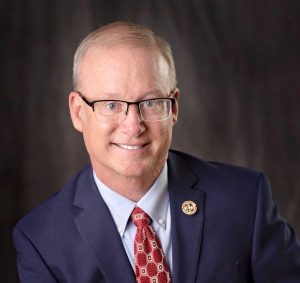State of the State 2023: Bank executives keep wary eye on economy
by January 20, 2023 12:09 pm 1,695 views

According to an executive with Arvest Bank – one of the state’s largest with nearly $26 billion in assets – the economy and its impact on businesses and consumers is a critical concern worth keeping an eye on entering a new year.
“I don’t expect a full economic recovery until late 2023 or mid-2024,” said Brad Crain, president and CEO of Arvest Benton County, the largest of the company’s 14 locally managed markets in Arkansas, Kansas, Missouri and Oklahoma. “So, for sure, economic recovery will remain uncertain and impact decisions businesses and individuals make.”
Crain said that while Northwest Arkansas – one of the country’s fastest-growing and dynamic regions – feels “somewhat sheltered” from overall macroeconomics, banks must maintain strong credit quality standards.
“Operating from a position of strength provides an opportunity for growth while competitors may be turning inward to stabilize,” he said. “Additionally, our conversations with our commercial customers are always advisory based. But in times of uncertainty, we lean into our customer conversations to ensure they know we are available for advice and strategy and are truly positioning themselves to weather potential economic hurdles.”
Other Arkansas bank executives who offered their outlook on the upcoming year echoed Crain’s optimism. Heather Albright is president of the Arkansas market for Bank of America (BofA), the nation’s second-largest bank with $2.4 trillion in assets. Bank of America has 15 financial centers, one Bank of America Private Bank branch, five Merrill Lynch offices and 260 employees in Arkansas. In addition, the bank has $6.7 billion in FDIC deposits, made $938 million in loans to commercial businesses, and provided $154 million in credit to small businesses in the state.
Albright said that despite the expected economic downtown, she expects continued resilience of consumers and corporations.
“It remains to be seen how deep and long of a recession we could see,” she said. “But if both groups employ prudent spending and cost-cutting, each can continue their growth strategies and remain financially healthy.”
She said the effects of an economic downturn could cause corporate budgets to shrink, so the private sector needs to work closely with community organizations to ensure vulnerable community members have what they need.
“Bank of America will continue to work with local leaders and organizations to address critical issues and gaps across Arkansas,” she said. “We will continue to provide capital and resources to help serve basic needs, remove barriers to economic success and help build a more sustainable community.
Albright also sounded optimistic when referencing a recent publication by the Bank of America Institute, which said the American consumer has proven resilient throughout 2022. And while 2023 is likely to be more challenging, significantly if the labor market deteriorates, consumers are starting the year in good overall financial health.
“Median household savings and checking balances remain well above pre-pandemic 2019 levels across all income [levels],” she explained. “While there are increasing signs that these ‘buffers’ are being drawn upon – likely due to high inflation and rising housing costs – they should be available for some time.”
She said most consumers are spending less on credit than debit cards compared to 2019 levels.
“Only those with incomes above $100,000 appear to be spending relatively more on credit cards, though that’s likely a function of increased spending instead of the accumulation of higher credit card debt,” she said.

Randy Scott is the president and CEO of Farmers Bank and Trust Co., a $342-million asset lender in Blytheville. He is also the chairman of the Arkansas Bankers Association. He echoed Albright’s comments about consumers’ financial health due to inflationary pressures.
“[Inflation] has affected some of our customers’ financial statements and their ability to repay,” he said. “So far, delinquencies have been minimal. However, we are noticing cash reserves disappearing and loan demand slowing down. Our lenders are trying to avoid any deteriorating financial conditions of our borrowers and particular industries that may be affected.”
Scott said despite inflationary concerns and the rapidly rising rate environment, community banks remain very strong with few asset quality issues.
“We hope that interest rates and inflation will stabilize in 2023 and the banking industry will show little negative effects,” he said. “I anticipate bank earnings will be down in 2023 with tightening interest rate margins and possible increases to loan loss reserves.”
Scott said interest rate repricing is the biggest concern on loans and deposits.
“With the Federal Reserve increasing interest rates by 400 basis points in 2022 alone, it has caused a challenge to banks,” he said. “Liquidity has become an issue with non-banks competing for our deposits. Consumers are finding attractive rates outside of community banks and with financial institutions outside of the state.”
Crain said many customers are concerned about the economy and inflation and are asking questions about when rising interest rates will plateau. He anticipates a continued decline in traditional mortgages for the first quarter of the year, and consumers may seek to unlock the equity they have in their homes in 2023.
“Our volume of home equity loans and lines of credit has been increasing, and we believe customers will seek this fixed rate option in the near term,” he said.
Leveraging technology for various reasons will continue to be a trend that bankers lean into in 2023.
“We continue to find ways to be more efficient in using technology to compensate for the limited workforce,” Scott said. “During 2020, COVID helped accelerate our industry into providing more services electronically. We learned we can do more with fewer employees by leveraging technology.”
Crain said rapid online and mobile banking expansion hadn’t eliminated the importance of in-branch banking or call center service. It has increased customers’ expectations for seamless integration across all service lines.
“Digital expectations of the customer and their changing service needs and expectations have the potential to have the greatest impact on our customer satisfaction and overall growth,” he said. “We have seen major shifts in how customers approach the bank and desire their service.”
Editor’s note: The State of the State series provides reports twice a year on Arkansas’ key economic sectors. The series publishes stories to begin a year and stories in July/August to provide a broad mid-year update on the state’s economy. Link here for the State of the State page and previous stories.
